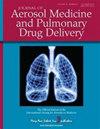Optimal Inhalation Profile of Pressurized Metered Dry Powder Inhaler Using a Valved Holding Chamber: A Dynamic Analysis.
IF 2
4区 医学
Q3 RESPIRATORY SYSTEM
Journal of Aerosol Medicine and Pulmonary Drug Delivery
Pub Date : 2024-04-22
DOI:10.1089/jamp.2023.0019
引用次数: 0
Abstract
Background: The combined use of a pressurized metered-dose inhaler and valved holding chamber (pMDI+VHC) is recommended to improve efficiency and safety; however, aerosol release is likely to vary with the inhalation maneuver. This in vitro study investigated the aerodynamic characteristics and aerosol release features of pMDI+VHC (Aerochamber, Trudell Medical International). Methods: The static and dynamic changes in the airway resistance (Raw) during inhalation (withdrawal) through pMDI+VHC were measured. Subsequently, the aerosol released from pMDI+VHC was measured using simplified laser photometry during withdrawal with either fast ramp-up then steady or slow ramp-up followed by gradual decrement at different intensities and times to peak flow (TPWF). Results: Raw increased linearly with changes in the withdrawal flow (WF) rate between 10 and 50 L/min. The slope was steep in the low WF range (<50 L/min) and became milder in the higher range. The aerosol mass tended to increase with an increase in the peak WF (PWF) of slow ramp-up profile. When three different WF increment slopes (TPWF: 0.4, 1.4, and 2.4 seconds) were compared, the released aerosol mass tended to decrease, and the aerosol release time was prolonged at longer TPWF. When the PWF was increased, the aerosol release time became shorter, and the withdrawn volume required for 95% aerosol release became larger; however, it did not exceed 0.4 L at suitable TPWF (0.4 seconds). Conclusion: Raw analysis suggests that inhalation at 30-50 L/min is suitable for pMDI+VHC in this setting. Rapid (TPWF, 0.4 seconds) inhalation, but not necessarily long (maximum 2.0 seconds) and deep (but larger than 0.55 L), is also recommended. Practically, direct inhalation to be weaker than usual breathing, as fast as possible, and far less than 2.0 seconds.使用阀式保持室的加压计量干粉吸入器的最佳吸入曲线:动态分析
背景:建议联合使用加压计量吸入器和阀式容纳室(pMDI+VHC),以提高效率和安全性;但是,气溶胶释放可能会随吸入操作的不同而变化。这项体外研究调查了 pMDI+VHC (Aerochamber,Trudell Medical International)的气动特性和气溶胶释放特征。方法:测量通过 pMDI+VHC 吸入(撤出)时气道阻力(Raw)的静态和动态变化。随后,在不同强度和达到峰值流量(TPWF)的时间内,使用简化激光光度计测量 pMDI+VHC 在撤出过程中释放的气溶胶。结果:在 10 至 50 升/分钟之间,Raw 随抽吸流速(WF)的变化呈线性增加。在低 WF 范围(<50 升/分钟)内,斜率较陡,在高 WF 范围内,斜率变得较缓。气溶胶质量随着缓慢上升曲线的峰值 WF(PWF)的增加而增加。比较三种不同的 WF 增量斜率(TPWF:0.4 秒、1.4 秒和 2.4 秒),释放的气溶胶质量趋于减少,TPWF 越长,气溶胶释放时间越长。当脉搏波速度增加时,气溶胶释放时间变短,95% 的气溶胶释放所需的抽吸体积变大;然而,在合适的脉搏波速度(0.4 秒)下,抽吸体积不超过 0.4 升。结论原始分析表明,在这种情况下,以 30-50 升/分钟的速度吸入 pMDI+VHC 是合适的。还建议快速(TPWF,0.4 秒)吸入,但不一定要长时间(最长 2.0 秒)和深度(但大于 0.55 升)吸入。实际上,直接吸入要比通常的呼吸弱,速度越快越好,而且要远远小于 2.0 秒。
本文章由计算机程序翻译,如有差异,请以英文原文为准。
求助全文
约1分钟内获得全文
求助全文
来源期刊
CiteScore
6.70
自引率
2.90%
发文量
34
审稿时长
>12 weeks
期刊介绍:
Journal of Aerosol Medicine and Pulmonary Drug Delivery is the only peer-reviewed journal delivering innovative, authoritative coverage of the health effects of inhaled aerosols and delivery of drugs through the pulmonary system. The Journal is a forum for leading experts, addressing novel topics such as aerosolized chemotherapy, aerosolized vaccines, methods to determine toxicities, and delivery of aerosolized drugs in the intubated patient.
Journal of Aerosol Medicine and Pulmonary Drug Delivery coverage includes:
Pulmonary drug delivery
Airway reactivity and asthma treatment
Inhalation of particles and gases in the respiratory tract
Toxic effects of inhaled agents
Aerosols as tools for studying basic physiologic phenomena.

 求助内容:
求助内容: 应助结果提醒方式:
应助结果提醒方式:


